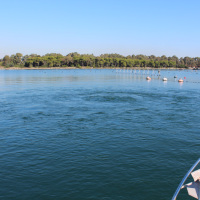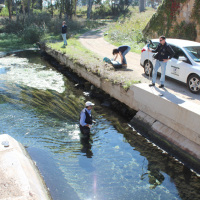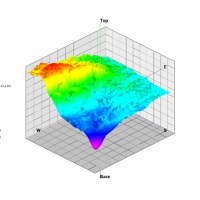How much Mar Piccolo peculiarities are due to groundwater outflow
A hydrogeological multi-methodological research quantifies the fresh yield groundwater outflow into Mar Piccolo

The Mar Piccolo basin is an internal sea basin located along the Ionian coast (Southern Italy), and it is surrounded primarily by fractured carbonate karstic environment.
In primarily karstic environments, infiltration is greater than runoff; in the karstic coastal Apulian aquifers, the groundwater discharge to the sea is more than two-fold greater than the surface discharge, notwithstanding the high discharges by wells. In such environments, including the Mar Piccolo area, the quantity and quality of groundwater outflow caused by of coastal submarine and subaerial discharge play key roles in the ecological equilibrium of these coastal environmental systems and are particularly important for biodiversity and environmental protection
The Mar Piccolo basin represents a peculiar and sensitive environment and a social emergency because of sea water and sediments pollution. The average seawater salinity of Mar Piccolo is lower than that of the close outer sea because of the inflow of fresh spring water, notwithstanding the effect of evaporation.
The research aimed to define the contribution of subaerial and submarine coastal springs to the hydrological dynamic equilibrium of this internal sea basin. A general approach was defined, including a hydrogeological basin border assessment to detect inflowing springs, detailed geological and hydrogeological conceptualisation, in situ submarine and subaerial spring measurements, including chemical and isotope analyses, and flow numerical modelling.
Multiple sources of data were obtained to define a relevant geodatabase, and it contained information on approximately 2,000 wells, located in the study area (1,600 km2). Five surveys were performed to acquire hydro-geochemical data and spring flow-yield measurements; the isotope groundwater age was assessed and used for model validation.
Results
The mean annual groundwater outflow in the Mar Piccolo was assessed equal to 107 106 m3 (75 and 32 106 m3 due to the main springs and diffuse seepage together with small submarine springs respectively). The mean groundwater outflow yield of the main springs was 2.4 m3/s (75.2 106 m3 per year). For each of the main springs the mean monthly outflow was assessed, showing a very low variability by month to month.
The geochemical data showed limited salinization of the groundwater outflowing from the subaerial coastal springs by seawater intrusion and a mixing ratio with seawater of less than 10%. Apart from mixing, the groundwater composition of the subaerial springs of Mar Piccolo is controlled by the combined effects of calcite dissolution and ion exchange. Enrichment of calcium and hydrogen bicarbonate together with depletion of magnesium ions was observed.
The highest travel time (approximately 1,500 years) is so high to suggest the variability of the main chemical groundwater characteristics due to variability of natural conditions as climate change and/or sea level change will be very low over time.
Granting institutions
- Italian Flag Project “RITMARE – La Ricerca Italiana per il Mare” which was coordinated by the National Research Council and funded by the Ministry for Education, University and Research within the National Research Programme 2011-2013
To know more
Link to Hydrology group website »
Zuffianò L E, Basso A, Casarano D, Dragone V, Limoni P P, Romanazzi A, Santaloia F, Polemio M. 2015. Coastal hydrogeological system of Mar Piccolo (Taranto, Italy). Environmental Science and Pollution Research, p. 1-13. DOI:10.1007/s11356-015-4932-6.








 Contact person: maurizio polemio -
Contact person: maurizio polemio -